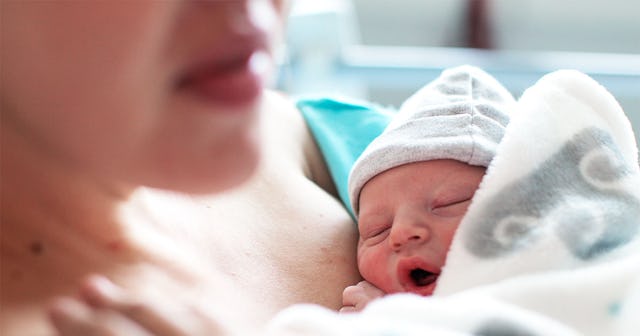Don’t Freak Out If The Doc Sends Your Placenta To Pathology

It’s been (checks watch), about 6 1/2 years since the thought of childbirth, labor, and everything that comes along with it were even on my radar. In that time, things have drastically changed when it comes to what we know, and more specifically, what we talk about when it comes to the nitty-gritty. Yes, I’m talking about after birth.
No, I don’t mean those tear-jerking, angelically beautiful first moments with your newborn swaddled in your arms. I’m talking about the part that your gyno probably mentioned but glossed over in a way that made it seem like you would hardly notice what was going on. Maybe it’s just me, but I definitely noticed, and was honestly confused about why the nurse seemed to be attacking my abdomen after my body had just pushed a 10 pound child out (okay, maybe attacking is a little dramatic). The second time around, I knew what to expect and had a little more patience. Ugh, if you must poke and prod away. Don’t take the death glares personally. This is just my least favorite part of the whole delivery process.
Honestly, I don’t know what happened to my placenta after it was extracted. Some people donate them, plant them, or… are you ready for this? Some people eat them. I swear I’m not judging. It’s just definitely not my jam, though I wondered why someone might do this. Apparently, it’s been said to help with postpartum depression. The jury is still out on whether or not there is any scientific backing for this, but hey, to each their own. With that being said, whatever plans you have for your placenta after bringing your beautiful bundle of joy into this world, don’t be freaked out if pathology takes a peek at it first.
Why Might Your Placenta be Sent to Pathology?
Carol Yepes/Getty
Your placenta has been a cozy little home to your pride and joy for the last 40+ weeks. In that time, it’s done essential jobs like getting your baby oxygen and nutrients to aid in their growth and development. There is no need to worry if it’s sent out to pathology for a second look. Unless you’ve been told otherwise, they are likely just examining it to make sure it’s looking healthy and normal.
But what do normal placentas look like? According to American Family Physician, placentas will vary from mother to mother, but a few things they’re checking on are its size, color, membranes on the placenta, as well as the length and diameter of the umbilical cord. All of these aspects can tell your doctor more about the health of your pregnancy, your newborn, or possible complications for subsequent pregnancies. Most of the time, any serious issues like placenta previa or placenta accreta, incretia, or percreta will have been diagnosed in the beginning to middle of the 2nd trimester. These conditions have to do with the placenta growing in the wrong spaces like, over the cervix, too deeply in the uterine wall, or all the way through it. For some doctors, it’s all part of a standard routine. Fingers crossed, there isn’t anything of concern. But there are some things that your doctor might talk to you about after the examination.
What To Expect After
Layland Masuda/Getty
It is essential that your entire placenta is birthed and expelled from your body. After all is said and done, this allows your provider to make sure everything that should be removed, has been. Leaving any part of your placenta attached (when this happens, it’s called “retained placenta”) can cause infection, hemorrhaging, or death. Your provider will examine you for any signs of retained placenta, and will make sure that all components of the placenta have been fully delivered. They will also visually examine the placenta for any abnormalities.
Once they know this has been taken care of, they may pass it on to pathology for a more in-depth analysis. Then it’s time for you to sit back and relax while nurses numb everything down there and stitch back up anything that needs stitching. Don’t worry. It sounds worse than it feels. I mean, you just birthed an entire human person. You are officially a pro now. And for parents who birth via a C-Section, you will also experience a lot of stitching and everything that comes with that. Before everything has been said and done, your provider will also have removed your placenta.
If your placenta is sent to pathology, here’s what will happen, according to Dr. Chavez, the director of Fetal Surgery at NYU Winthrop Hospital, who described the process to Parents. First, they will take a look for signs of abnormalities. For example, calcification or clotting are not things you typically see with a healthy placenta. Factors that play a part in these conditions developing are sometimes out of our control, like genetics or pre-existing conditions. Knowing that ultrasounds don’t always catch everything, an examination of the placenta, especially for first-time mothers is usually no cause for concern. Pathology can also screen for bacterial infections in the placenta.
“Ultimately, analyzing the placenta will provide doctors with information on the current pregnancy and birth and potential insight for future pregnancies,” Dr. Chavez tells Parents.
In the same way, every pregnancy will be different, every placenta will be different too. There are certain things you can control when it comes to the health of both. Don’t smoke, don’t drink, and try not to stress out too much. Most importantly, make sure you are in constant, honest communication with your provider. Honestly, you might not even notice all the hullabaloo as you snuggle and cuddle your sweet little one. Enjoy finally meeting this small person who you love with all your heart. Even more than you loved those ridiculous pregnancy cravings.